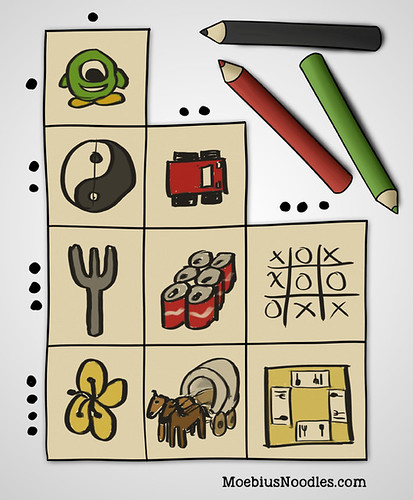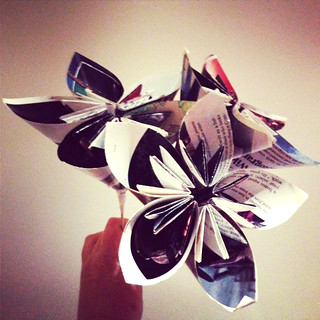Week 4 Task 2: Real times tables

Today your mission is…
Fill times tables with personally meaningful examples. This task helps to develop fluency and applications of multiplication.
Ready, Set, Go
This activity scales up and down: you can spend five minutes, or five hours, or five years hunting for the elusive facts. Don’t worry about finishing it all in a day. Just as with any other collections, this one will grow and become more meaningful over time.
Go on a scavenger hunt for examples of multiplication in nature, designs, or stories. Prepare index cards or sticky notes, and a times table grid large enough to fit them. Every time you find an example, sketch or describe it, and put it in the right cell. Some combinations are easier to find than others, so you can have multiple cards in the same cell. Decide what to do about the symmetric times facts, like 2*5 and 5*2. Take photos of happy hunters with their finds and creations!
For an extra challenge, seek iconic examples, where objects always go with particular numbers. Hands and fingers always mean 2x5, and the chessboard is always 8x8.
If you are into arts, crafts, or engineering, make your collection beautiful. Go from a sketch to a full art piece. Compose your photos nicely. Design a complex Lego sculpture or Minecraft building. Turn a description of a situation into an engaging story. Make a poster, a collage, a gallery, or a diorama out of your collection.

By Sabdha C.
Your forum response
- What multiplication ideas do you see in this topic? What bridges connect this to your everyday life, sciences, and arts?
- Did you use this with kids or students? How did it go? What did they say and do? What questions did they ask?
How to help your child to get started
Where can you go hunting?
- On a field trip. Your yard, a park, a museum, a fire station, a zoo… Give each group of participants a camera to capture their finds. Invite them to point out multipliers they find with their hands or whole bodies for extra awesome photos.
- To your home. Find multiplication in toys, pets, decorations, books. Make mobiles or sculptures about multiplication.
- To a virtual world. Find and build multiplication in the universes people created, such as Minecraft, Star Wars, Dungeons and Dragons, and Harry Potter. Let kids pick destinations.
- To a box of construction toys and art materials. How many different ways can you show the same multiplication example with Legos? Can you paint it, sculpt it, fold it, cut it?
- Through history and ethnography. Check out what different times and cultures did for their multiplication, from playing dice to building abacuses.
- Into a trade. How do nurses, astronauts, musicians, or homesteaders use multiplication? You can interview a real tradesperson, or pretend-play about sci-fi, historical, or future professions, such as alchemists, Mars settlers, or time travelers.
- Into the imagination. Make up stories and art devoted to multiplication. Play “Imagine That!” by making silly changes to the world: a hand with fingers at the tips of fingers, a dog with eight legs, an alien planet where numbers only went up to three.
Frequently Asked Question
You frequently mention celebrating mistakes. But how to do it? And why? In life, making a mistake may lead to unfortunate or tragic consequences. Does celebrating mistakes mess up children’s respect for serious thinkers of the past?
You would not celebrate a mistake in building a bridge, or in getting the distance to Mars wrong and missing your landing window! However, there is a side of mathematics that is more whimsical and free. Mathematics can be not only about measuring this world where we live, but about making up other, fantastic worlds. In that, mathematics is closer to fairy tales, or science fiction, or fine arts where you can create rather freely. So when I talk about celebrating mistakes, I mean taking them from our world into one of those mathematical Wonderlands.
For example, my math circle kids kept confusing squares and cubes, or circles and spheres. But we played with it, and by now, they talk about three-dimensional squares - or even four- and five-dimensional! This road from mistakes to abstractions is a big part of the history of serious mathematics, from imaginary numbers to non-Euclidian geometries.
Words
Array, area, number line, set, combinations, symmetry, fractal, scale
People who like this
Your answer

Answer by annettehaddad · May 27, 2014 at 10:46 PM
We are keeping math journals and are incorporating this activity into our journals. Photos and drawings are filling up the chart and the kids are noticing things everywhere- in the park, in the car, grocery store, etc. I am really enjoying seeing them make the connection with math and real life and using more mathematics vocabulary in their everyday speech. I am hoping this early exposure will help them to not be afraid of math as they progress through higher mathematics as they get older.
Answer by Eogruen · May 20, 2014 at 06:43 PM

this was a fun activity for all. I can tell my seven year old is starting to understand multiplication in a more concrete numbers based way. We are a long way from memorizing or even using a chart much, but the concepts are starting to make sense and she understand x 0 and x 1. Some of her suggestions also made me realize that she really "got" the factor chart idea and used it to create some of this chart. My four year old loved the use of stickers and the baby enjoyed chewing on some sticker boxes...
Answer by Rodi.Steinig · May 08, 2014 at 06:46 PM

Going out into the neighborhood with cameras was a wonderful follow up to the mult bingo activity. The girls found example after example of things - many were mult, and some weren't but were mathematical in some other way. On the walk we discussed how we are seeing that everyone has a mathematical/architectural instinct to find structure and patterns in our surroundings. When we came back in, it was much more challenging to transpose the visual images into numerical language. Many of the images were small sections of fences, bricks, etc, so figuring out what numbers to use was tricky. We had a good exercise how in math you sometimes have to make awkward assumptions just to push the problem forward. Also, some of the items had numbers that were just too big for the paper times tables - a useful lesson there too. The girls discovered how each set of factors has 2 places on the table. They all went home with at least a few filled in.

@Rodi.Steinig - children may see the structure of the situation (e.g. that the wire fence is a grid) without seeing particular numbers. Algebra without arithmetic, so to speak. I find this intriguing.
I find this intriguing too Maria - especially because I tend to attract students who claim to not enjoy math. I think that the opportunity here to use metacognition here to arrive at an appreciation of math is great. It's wonderful to help kids realize that math isn't what they think it is. One of the parents of these kids in the photo emailed me after this session that "Because of your Girls Math Circle, (my daughter) has a whole new perspective on Math. I can't thank you enough Rodi!" Thank you, Maria and Yelena, for sharing all of these wonderful activities.
Answer by LeistCatalano · May 02, 2014 at 01:12 PM
I set up this table and had my kids help me fill it in. We didn't quite get it all filled in before the 1yo did the work. Still it was a good start and they were engaged with filling it in.

Later I noticed my 5yo had made a similar chart on the chalk board. Was counting to 9, not multiplication, but it showed he was thinking about it.

@LeistCatalano - I see your 5yo attempting to carry on the structure, from one cell to the next. He does not keep all of it consistent, which is typical: very few kids (even teens!) make globally consistent tables from scratch, on their first attempt.
Check it out: the second row has 2 and 4; the third row has 3 and 6, and in the fourth row you see 4, 6, 8. The global structure is not yet there, but you can see local multiplicative reasoning if you go cell by cell. Yay!
Answer by Elizabeth02 · May 01, 2014 at 03:41 AM
As much as I love the idea of finding stuff, I had a time frame to work with as well a child that seems to have trouble locating his own feet some days. We did make a pretty fun multiplication table on his wall though. He found some cool patterns, as well as some that did not really repeat, but I encouraged him to keep exploring anyway. I made up the cards and put them in a pile for him to fill in the chart with. He enjoyed it quite a lot, and maybe now that we have this as a base, we could substitute in drawings as we find the objects over a few months.

sorry it is so fuzzy.
@Elizabeth02 - the photo is clear enough to see a happy kid! Thanks for sharing this joy. And the way you tackle the task is an option we need to recommend in the future, at least for kids who already know what multiplication is. For younger kids who are still learning the concept, the option will be to leave cells blank, and to find the answers from their finds.
Answer by babyhclimber · Apr 29, 2014 at 01:45 PM
My son found some awesome multiplication games & tables on scratch:
http://scratch.mit.edu/projects/18722382/
http://scratch.mit.edu/projects/751554/
http://scratch.mit.edu/projects/2802811/
http://scratch.mit.edu/projects/13251259/
Scratch was working fine earlier this morning but right now the server is down for maintenance, so if it is down try it again later. Finding these made my son's day... He loves messing with scratch.
Follow this Question
Related Questions
Week 4 Task 4: Coloring the table 4 Answers
Week 4 Task 5: Healthy memorizing 1 Answer
Week 4 Task 1: Multiplication models bingo 9 Answers
Week 4 Task 3: Decanomial squares 11 Answers

